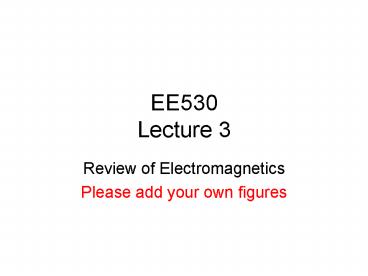EE530 Lecture 3 - PowerPoint PPT Presentation
1 / 12
Title:
EE530 Lecture 3
Description:
... solved for the reflection coefficient R and ... Total reflection when i i0 ... Light enters from fiber end and is transported by total internal reflection ... – PowerPoint PPT presentation
Number of Views:41
Avg rating:3.0/5.0
Title: EE530 Lecture 3
1
EE530 Lecture 3
- Review of Electromagnetics
- Please add your own figures
2
Maxwells equations
- We use cgs units in this course. Maxwells
equations are
rfree charge, Jcurrent
One major difference in this course from standard
electromagnetic books is that the dielectric
function e or the magnetic permeability m is a
function of position and have spatial
derivatives We will not use the polarization P or
magnetization M. Instead we use E,H, e, m
3
Wave equation
- Assume no free current or free charge r0, J0
(note that antennas require a current source) - Maxwells equations are
EM waves in uniform media Assume e(r)e m(r)m
(constant values) Take the curl of the curl E
equation to get the wave equation, which
decouples the fields
This is the wave equation for each component of E
and H. The wave has velocity v c/vem c/n
c3108 m/s in vacuum n vem is the refractive
index. Wave traverses more slowly in a dielectric
medium by the factor 1/n.
4
Electromagnetic waves
- Plane electromagnetic waves have solutions
- E(x,t)E0e ik.x-iwt
- H(x,t)H0e ik.x-iwt
- Wavevector k vem w/c nw/c is the amount of
momentum in the wave - Use plane wave solution in Maxwells equation to
relate E and B (or H)
E, B, k form a right-handed triad of vectors
k.E0 k.B0 (transverse waves) Wave traveling
along the z direction Wavelength
l2p/kv/f Impedance of the mediumratio of
electric magnetic field Impedance is a
characteristic property of the medium In free
space Z377 ohm in mks units or Z1 (cgs units)
5
Energy flow
- Poynting vector S describes time averaged flow
of energy - S is real and in the direction of k
- Intensity IE02
- Larger Z reduce the energy flow similar to
reducing the current flow when the resistance is
larger
6
Reflection and refraction of waves
Z0
- General case wave incident from media em to
semi-infinite medium e m
Boundary conditions must be satisfied at all
times on the plane z0 Spatial and time variation
of the fields must be the same at z0 (k.x)
(k.x) (k.x) at z0 k sini k sinr
ksinr rr Snells law Will later see
differences for negative refractive index
materials
7
Boundary conditions
- Continuity at interface of
- Normal components of D (from divergence equation)
- Normal components of B
- Tangential components of E (from curl equations)
- Tangential components of H
8
S-polarized TE mode
- Electric field perpendicular to plane of
incidence - From continuity of tangential components (3), (4)
should obtain two equations relating E and E to
E
TE
These can be solved for the reflection
coefficient R and transmission coefficient T
9
Normal incidence
- Simplifies result for reflection and transmission
- Same result for both polarizations
Go from air with n1, (or less dense medium) to
more dense medium find that ratio E/E is
negative Phase change on reflection For a very
dense medium (n large) or for a metal, the
reflected wave cancels out the incident wave so
that no wave goes inside the medium and boundary
conditions are satisfied Glass n1.5 R4, T96
10
P-polarized TM mode
- Magnetic field H is perpendicular to plane of
incidence - Use continuity of tangential E and H fields
Solve two equations for two unknowns to get
reflection and transmission
For normal incidence should get the same results
as TE polarization
11
Total internal reflection
- From higher index to lower index material
- The refracted angle r90º when the incident angle
is at a critical value - i0 sin-1(n/n)sin-1(n) (n1)
- Total reflection when igti0
- Field is attenuated in the z direction
evanescent field at interface - Principle of optical fibers dense core (glass
n1.5) surrounded by lower index cladding
material - Light enters from fiber end and is transported by
total internal reflection - Entering light has to be incident at less than
the critical angle
12
Fiber optics
- Attenuation vs wavelength shows lowest loss at
1.55 m and low loss at 1.3 m - There is OH absorption at l1.4 m from residual
water in SiO2(OH stretch vibration at very high
frequency) - Transmission bands
- Long wavelength band l1.55m lowest loss 0.26
dB/km - Medium wavelength band l1.3m loss 0.4 dB/km
- Short wavelength band l800-900 nm high
absorption - Typical fiber dimensions
- Core 50 m diameter
- Cladding 125 m diameter
- Fiber is 50/125
- Bend fibers Need bending radius R to be several
wavelengths l, to achieve low loss around bend.
Typical optical fiber has few mm bend - This problem can be solved by using photonic
crystals with small radius bends































